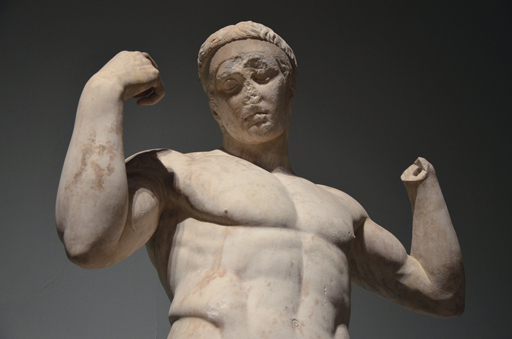1.2 Healthy bodies in the ancient world
Other than looking at the ideal bodies of sculpture, how can you find out about the realities of bodies in health?
Ashes were already falling, not as yet very thickly. I looked round: a dense black cloud was coming up behind us, spreading over the earth like a flood. ‘Let us leave the road while we can still see,’ I said, ‘or we shall be knocked down and trampled underfoot in the dark by the crowd behind.’ We had scarcely sat down to rest when darkness fell, not the dark of a moonless or cloudy night, but as if the lamp had been put out in a closed room. You could hear the shrieks of women, the wailing of infants, and the shouting of men; some were calling their parents, others their children or their wives, trying to recognize them by their voices.
Here Pliny the Younger describes his escape from Misenum, during the disaster that killed his uncle (Pliny the Elder, writer of Natural History). This disaster was the eruption of Vesuvius, a volcano to the east of Misenum, which you read about in Week 3, and which is known most about from its effects in Pompeii and Herculaneum, further to the south-east of Vesuvius and over 50 km from Misenum, although this is only because the remains of these towns have been discovered.
Many of the individuals killed in 79 CE had changes in their tooth enamel which would suggest a period of serious illness or perhaps of food shortage, preventing them assimilating calcium. The food supply in antiquity was always erratic. The huge city of Rome relied on imports and these were affected not only by crop failure, but also by bad weather or warfare preventing ships from sailing. There is skeletal evidence of chronic conditions, such as arthritis, found in 35 per cent of the joints which have been studied in Pompeii. Osteoporosis was also found, although women’s bone density was similar to that which is found today; men’s bone density was a little higher. The condition of individuals’ teeth differed considerably; 25 per cent of people from Pompeii had at least one dental abscess but the individuals from Herculaneum had much better teeth. The levels of fluoride in the water were higher in Herculaneum, which may explain this.
As for the overall shape of the healthy body, one individual, labelled by archaeologists as ‘Erc86’, was about 46 when he died. His bones were thick and heavy, which suggests his diet was very good, and his body was highly muscular, to the extent that scholars think he was a bodybuilder, exercising in order to look good or because he needed to be very strong. Perhaps he was an athlete; the muscles on the right side of his body were even stronger than those on the left, so his sport may have been the discus or javelin. Perhaps he was a gladiator, although there are no signs of injury on his body, so, if he was, he would have been a very good one! Another individual, ‘Erc28’, aged 16, had pronounced upper body strength, which archaeologists have compared to that found in modern fishermen. This suggestion could be supported by his teeth, which showed a pattern of wear that would fit with holding cord between the teeth while repairing nets.

